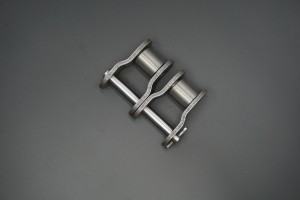Roller chains are an important component in many industrial and mechanical applications. They are used to transmit power and motion in a variety of machinery, including conveyors, agricultural equipment, and manufacturing machinery. Choosing the right roller chain for a specific application is critical to ensuring optimal performance and service life. With many types and sizes available, choosing the most suitable roller chain can be a daunting task. In this article, we will discuss the key factors to consider when selecting a roller chain to help you make an informed decision.
Understand the basics of roller chain
Before delving into the selection process, it is important to have a basic understanding of roller chains. A roller chain consists of a series of interconnected links with cylindrical rollers that mesh with the teeth of a sprocket to transmit motion and power. Chains are usually made of metal and are designed to withstand high loads and continuous operation.
Roller chains come in different sizes and configurations, including single, double and multi-chain. They are also available in a variety of materials, such as carbon steel, stainless steel, and nickel-plated steel, each offering varying levels of strength, corrosion resistance, and durability.
Consider application requirements
The first step in selecting a roller chain is to evaluate the specific requirements of the application. Consider factors such as load capacity, speed, environmental conditions and operating temperature. For example, heavy-duty conveyor systems require roller chains with high tensile strength and wear resistance, while food processing machines may require chains that are corrosion-resistant and easy to clean.
In addition, the design of the sprocket and the layout of the machine should also be considered. Roller chains must be compatible with sprockets in terms of pitch, tooth profile and diameter to ensure smooth, efficient operation.
Choose the right size and spacing
The size and pitch of a roller chain are key factors in determining its compatibility with sprockets and the overall performance of the machine. Pitch refers to the distance between the centers of adjacent rollers and is a critical dimension that must match the sprocket pitch. Common pitch sizes for roller chains include 1/4″, 3/8″, 1/2″ and 5/8″, with each size suitable for different load capacities and speeds.
A roller chain must be selected with the correct sprocket pitch to ensure proper meshing and minimal wear. Additionally, the length of the chain must be determined based on the distance between the sprockets and the tension required in the chain.
Evaluate load and speed requirements
When selecting a roller chain, the load capacity and operating speed of the machine are crucial considerations. The chain must be able to withstand the maximum load it is subjected to without stretching or breaking. It is important to consider any shock loads or intermittent stresses that may occur during operation.
Likewise, the speed at which the chain operates will also affect the selection process. Higher speeds require chains with precision manufacturing and tight tolerances to prevent vibration, noise and premature wear. Understanding load and speed requirements will help select a roller chain that meets the needs of the application.
Consider environmental factors
The operating environment plays an important role in determining the type of roller chain best suited for the application. Factors such as temperature, humidity, exposure to chemicals and contaminants can affect chain performance and longevity.
For applications in harsh environments, such as outdoor machinery or chemical processing plants, corrosion-resistant roller chains made of stainless steel or special coatings are recommended. These chains resist rust, chemical corrosion and abrasive wear, ensuring reliable performance in challenging conditions.
Evaluate maintenance and lubrication requirements
Proper maintenance and lubrication are critical to maximizing the service life of your roller chain. Some chains are designed to be low maintenance and operate without frequent lubrication, while others may require periodic lubrication to reduce friction and wear.
Consider the accessibility of chain maintenance and the availability of lubrication systems in the machinery. Choosing a roller chain that adheres to equipment maintenance practices and lubrication schedules will help extend its service life and performance.
Consult reliable suppliers
There are many factors to consider when choosing the right roller chain, and it may be helpful to seek guidance from a reputable supplier or manufacturer. A knowledgeable supplier can provide valuable insight into the selection process, recommend suitable chain options, and provide technical support to ensure that the selected chain meets the specific requirements of the application.
When consulting with your supplier, provide detailed information about your application, including operating conditions, load and speed requirements, environmental factors, and any special considerations. This will enable suppliers to provide tailored advice and assist in selecting the best roller chain for the application.
In summary, choosing the right roller chain is a critical decision that directly affects the performance, reliability and service life of machinery and equipment. By understanding your application requirements, evaluating factors such as size, load capacity, speed, environmental conditions and maintenance needs, and seeking guidance from a reliable supplier, you can make an informed choice when selecting a roller chain. Investing time and effort in the selection process will result in a well-matched roller chain that provides optimal performance and durability in your specific application.
Post time: May-31-2024

